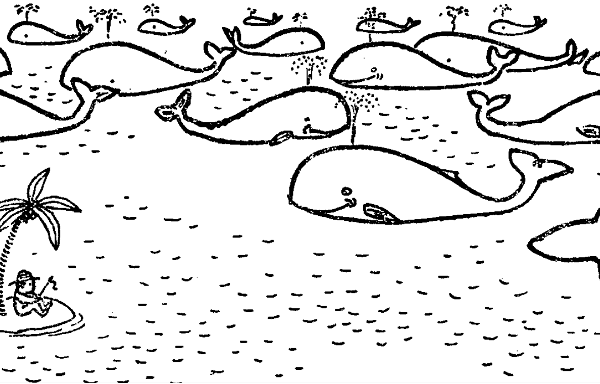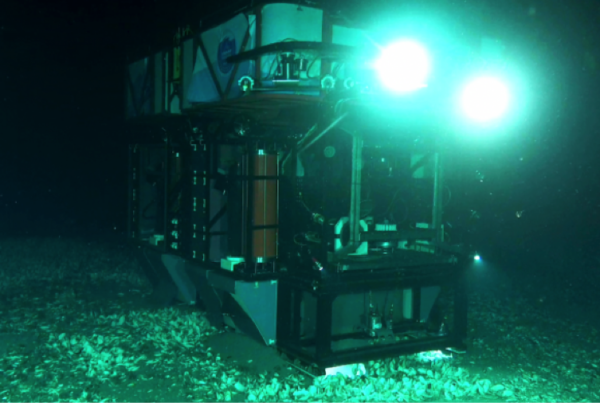He led the children all the way to the shark's head. He pointed between the shark's two eyes.
“Look, what’s here?”
Sasha bent down and almost pressed his eyes to it before he could barely see that it had just been operated on. There was a piece of skin the size of a cigarette box, sewn on with very, very fine thread.
“Oh!” He said with a start. “Uncle Yang, you’ve sewn something into the shark’s head.”
“How clever!” Professor Yang complimented, rubbing his hands together with a smug look on his face. “This is the fourteenth time I’ve done an operation like this.”
For the umpteenth time! What kind of operation is this? Sasha didn’t ask the question outright. He knew that Professor Yang would have to tell them everything soon enough.
…
“As you know, the shark is one of the fastest and furthest swimming animals in the sea. It is the king of the sea and hardly any animal can fight it. It can devour all animals. Even whales many times its size dare not attack.”
…
They entered another room. Professor Yang turned on the light. It wasn’t very bright but they could see clearly that it was a room with many instruments and a large television set in the centre of the wall. Professor Yang sat them down in a row of chairs and reached over and fiddled with one of the many buttons under the television.
Suddenly, a colourful underwater world appeared on the TV screen: coral clumps as red as blood, white sand dunes, giant kelp and oddly shaped fish swimming among them. Although the children come from the Xisha Islands, they have only swum on the surface and between the reefs. Even if they dive down, they can’t get a clear view in the deep sea. So, this stunning view of the deep sea captivated them. The strange thing is that the view of the seabed changes very quickly as if the person holding the camera is swimming at a very high speed. Sometimes it swings back and forth, sometimes the camera suddenly dives upwards, sometimes it sinks deeper into the sea. (Figure 1)
“Do you guys know who made this movie?”
A flash of thought suddenly came to Sasha’s mind and he speculated, hesitantly,
“Could it be a shark?”
“That’s right!” Professor Yang patted the teenager on the shoulder, clearly appreciative of his intelligence.
“Could that be a camera sewn onto the shark’s head? But the camera isn’t showing…” asked Agu.
“No.” Professor Yang casually turned off the television. “What we have sewn into the shark’s head is not a camera, nor a videographer, but a detector. It certainly doesn’t have a lens because the shark’s eyes are its lenses. What you are seeing is the view from the eyes of shark No.7, which is swimming near your island. What you see under the water is reflected in the retina of the shark’s eyes, which in turn is transmitted to its cerebral cortex, where some weak electrical currents called bioelectricity is immediately generated. Our detector amplifies this bioelectricity, reduces its frequency and sends it through the seawater to the TV screen. Understand? Think about it: the sea floor is pitch-black, and if we were to dive that deep ourselves, we wouldn’t be able to see anything without lighting. But the shark’s eyes are very sharp. Look how clearly it sees everything under the sea! Isn’t it fitting to use it as a scout of the sea?”
“But,” Sasha asked hesitantly, “doesn’t the shark always migrate around…?”
“It could swim further, couldn’t it?” Professor Yang narrowed his very bright eyes. “Yes, sharks can swim from our Western Sands all the way to Australia. But a shark that has been operated on by us will not travel that far. Because the detector we have sewn into its brain is also a controller. We can send out a command for this instrument to stimulate its brain. In this way, we can produce some bio-currents to direct it to flow towards our designated waters.”
“So that’s it!” Sasha exclaimed, “This apparatus must be very complicated!”
Professor Yang casually lifted a small metal-sealed box the size of a cigarette packet from the box next to the television and handed it to Sasha.
“This is it. It’s very complicated indeed, but it’s small. Put it in the shark’s head and it won’t even notice it. Well, that shark next door is about to wake up and needs to be sent back to the sea in a hurry.” Professor Yang led the three teenagers back to the main lab and asked, “What do you think? Is it better for you to chop this shark up? Or would it be better to keep it for me as a scout?”
Article source: Zheng, W. (1979). Shayu Zhenchabing (鲨鱼侦察兵, The Shark Scout), first edition. Beijing: Zhongguo Shaonian Ertong Press, 1979.
Author: Zheng Wen-guang
Translator: Dongyang Li

Figure 1. Professor Yang shows children the deep-sea world detected by the shark scouts
Image credit: Zheng, W. (1979). Shayu Zhenchabing (鲨鱼侦察兵, The Shark Scout), first edition. Beijing: Zhongguo Shaonian Ertong Press, 1979.

Figure 2. An award-winning entry of the 1st China Deep Sea Innovation Design Exhibition and Call for Entries (2022) – Cyber Lionfish.
This work is from the 1st China Deep Sea Innovation Design Exhibition. The designer’s description of the work: to explore the connection between blunt-mouthed lionfish and underwater soft-bodied robots, the prospects for their use and the ecological impact of future underwater soft-bodied robots on blunt-mouthed lionfish. The aim of the artwork design is to promote knowledge about blunt-billed lionfish and underwater soft-bodied robots, to extend their application and to explore the impact of robots and the deep-sea environment. The “robot fish,” which combines the blunt lionfish with the underwater soft-bodied robot, can be used for marine engineering, exploitation of marine resources, scientific research and surveys, underwater hull maintenance, etc.



